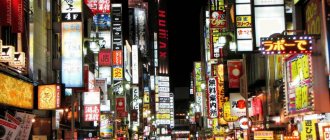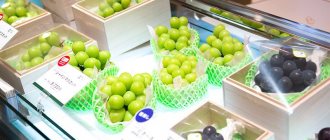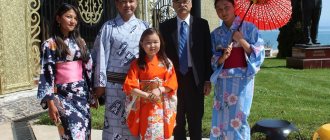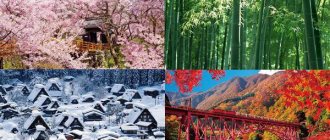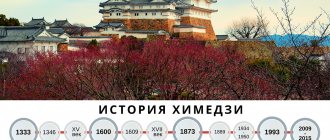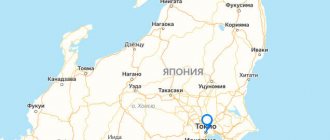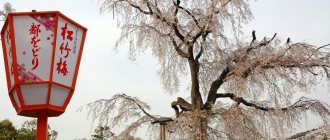Plants of Japan: characteristics and photos
Japan is located on a long, narrow island archipelago with a wide range of climates, from the subarctic region of Hokkaido in the north to the subtropical region of Okinawa in the south, and is characterized by well-defined seasons and abundant rainfall. The country is surrounded on all sides by ocean, and its inland geography is varied and complex, with many mountainous regions.
This great diversity of climate and geography has given rise to many species of plants and animals. The Japanese archipelago was spared the destruction of glaciers and the resulting mass extinction of plant life that took place on many continents. At the same time, the process of re-invasion and isolation from other plant species brought about by association with the Asian continent over millions of years contributed to the richness of Japan's natural flora.
Japan is the 48th country in the world in terms of flora diversity. Between 4,000 and 6,000 plant species are found here. Almost half of the species are endemic. The dominant biome of Japan is forest, the composition of which varies depending on region and altitude.
Bamboo forest
Vegetation varies widely from subtropical forest in the south to coniferous forest in the north. In the subtropical zone you can find mangroves, cicadas and ferns. In the warm climate of Kyusu, Shikoku and southwestern Honshu, the dominant vegetation is a broad-leaved evergreen forest with many oak trees.
Crenate beech
Northern Honshu and southwestern Hokkaido have a cool-temperate climate with broad-leaved deciduous trees including crenate beech (Fagus crenata) and oaks like pollen oak (Quercus serrata). Conifers dominate much of Hokkaido and the mountains of central and northern Honshu, with spruce and fir predominating. In the altitudinal regions there is a zone of arctic-alpine plants, where dwarf pine (Pinus pumila) also grows.
Cypress blunt-leaved
Plantation plantations have replaced natural forests in many areas of Japan. Commonly grown trees include common cypress (Chamaecyparis obtusa), densiflora pine (Pinus densiflora), thunberg pine (Pinus thunbergii) and Japanese cryptomeria (Cryptomeria japonica). Cryptomeria is the tallest coniferous tree in Japan, reaching 40 meters in height.
Bamboo grows in abundance throughout Japan with approximately 400-500 different species, including dwarf bamboos known as saza and taller species that can reach 20 meters in height.
Many plants were introduced to Japan from mainland Asia, including important crops such as rice and garden plants (chrysanthemum). Since the Meiji Restoration, an increasing number of plants have come from Europe, North America and other countries. Native edible plants include oysterwort (Oenanthe javanica) and wasabi (Wasabia japonica).
Sakura
Sakura is an important plant in Japan. Its flowers are a symbol in the culture of the people, and the image is widely used on coins, clothing, dishes and consumer goods. Folk songs are dedicated to sakura, and its flower is the main motif of the heraldry of the Japanese armed forces.
Traditionally, Japanese life - from the basics of food, clothing and shelter to their spiritual life - has been characterized by harmony with nature, and the land, maintained with great care over many generations, has become an integral part of the natural environment. This type of "controlled" natural environment has allowed many species of wild plants to flourish in Japan.
Japan's diverse and unique flora was created through a combination of human efforts and the country's ideal natural conditions.
Didn't you find everything? Use site search ↓
How to grow a symbol of the gods
Since this amazing flower is a plant that lives only in bodies of water, few people think of the idea of growing lotuses at home. There are such lovers - moreover, among them there are experimenters who managed to grow this flower in a bathtub (however, then they still had to take the plant to the pond).
Best articles: Leukemia in cats: what is it and why is it dangerous
In order for the embryo to “wake up” faster, you need to saw off the peel from the blunt end of the lotus seed, and then place the seeds in a jar of water. In about five days, a sprout will emerge from the seed and begin to grow. Having reached the surface of the water, the sprout will begin to unfold, forming a small lotus leaf.
Plants should be planted in a pond only in the warm season, when the danger of late frosts has disappeared (it is advisable that the water temperature at a depth of 0.5 meters be about 30 degrees)
Sprouts should only be planted in shallow water, carefully immersed in the soil to a depth of about six centimeters, so that the leaves remain on the surface (otherwise the young plant, not being able to gain a foothold with its roots, will drown)
When planting a plant, you need to take into account that the root can “fall asleep” for several years and wake up only when favorable conditions appear for its development. It is not for nothing that the lotus is a symbol of rebirth, because it managed to survive the Ice Age.
Birds
There are a lot of birds here, about eight hundred species. Synanthropic species (living near human habitation, but not domesticated) include swallows, large-billed crows and carrion crows.
The coast is home to many seabirds, cranes, and storks. The following have adapted to live in mountain forests in large numbers:
- woodpeckers,
- blackbirds,
- tits,
- starlings,
- black grouse,
- hawks,
- eagles,
- owls,
- common and blue magpies,
- kukshi,
- nutcrackers.
Green pheasant
Among them, green pheasant, amami woodcock, ornate jay are endemic species. Tropical fauna is characteristic of the southern part of Nippon.
Kitchen
What Japan is famous for can be learned from numerous books dedicated to the country and the history of the development of its cuisine.
Tea culture
Tea drinking is considered one of the oldest Japanese ceremonies. This ancient tradition is of great importance for all Japanese people without exception.
It is used during a special occasion and consists of several stages:
- The invitee must arrive 15 or 20 minutes in advance. before the scheduled ceremony begins.
- Regardless of the time of day, the windows in the room must be covered with thick curtains, shading the light and creating twilight.
- A small buffet table (kaiseki) is required before drinking tea. Only after a snack, the owner of the house and guests begin to drink tea.
Food culture
In Japan, food cultural studies are held sacred. Chefs pay great attention to proper serving of food and decoration of the dish itself. Before starting a meal, you should wipe your face and hands with a special napkin called oshibori, which is pre-moistened in hot water.
Next, you must adhere to the rules:
- chopsticks for eating must be placed on a special stand - hashioki;
- It is prohibited to pass dishes from your table to anyone;
- Do not stick chopsticks into rice dishes or cross them;
- in Japan it is strictly forbidden to use spoons while eating;
- During a meal, you cannot move the plates relative to the table and each other, each of them must stand in its own specific place;
- Moving around the plate of food is considered disrespectful to the cook;
- You cannot put a bitten piece of food on your plate.
How to properly care
It is surprising that the crimson plant originally came from the warm Land of the Rising Sun, however, despite the origin of the crimson plant, the plant adapts perfectly even to the climatic conditions of Russia. Moreover, it is able to cope perfectly even with very cold weather.
With regard to Japanese scarlet, frost resistance is, of course, important, but the most favorable climate for it will be subtropical. This is the reason why care and planting of the plant comes to the fore, especially at the initial stage of scarlet development.
In summer, you need to ensure that the soil is not too dry. For Japanese scarlet, care mainly consists of ensuring a sufficiently high level of moisture in the soil.
That is why during periods of drought it is necessary to organize watering of the plant when the soil becomes dry. It is advisable that the crop is not exposed to huge amounts of sunlight, as they can significantly burn the plants. It is good if the crimson seedlings are in partial shade.
When choosing suitable soil, pay attention to favorable soil for growing the plant, which has low acidity. In addition, it is for this reason that the leaves of the European scarlet are characterized by such a bright color
But Russian birch is not inferior in its brightness in the autumn.
Marine life
In the region of the Sea of Japan in winter, due to the northeast wind characteristic of this season, there is heavy snowfall, which is rarely observed in the Pacific Ocean. Summer is colder than in the Pacific coast area, where this season is usually hot and humid, but winter is cold here. All this creates conditions for six hundred species of fish to live in coastal waters: Pacific herring, willow, tuna, cod, flounder and others.
spider crab
In the list of thousands of species of shellfish, in addition to crabs, shrimp and oysters, there are also exotic ones; it’s not for nothing that Japan is famous for its seafood cuisine. The rivers here are home to catfish, carp and lamprey. And eels and salmon, for example, trout, are grown artificially.
Notes
- ↑ 1 2 3
Forest area
(unspecified)
. The World Bank Group. Access date: October 11, 2015. - ↑ 1234
æ—¥æœ¬ã ®æ£®æž—é ¢ç© ã ¨æ£®æž—çŽ‡ - Of the 37.8 million hectares of the entire territory of Japan, 25.15 million hectares are covered with forests, or 66.6% of the country's area. Added from Encyclopedia "Japan from A to Z" (inaccessible link) (inaccessible link since 06/14/2016 [1838 days])
- Japan#Geography
- “ Œv‹Çƒz [ƒ€ƒy [ƒW/“ú–{‚Ì“ Œv |1 '“y—˜—p‚ÌŒ”‹µ
- “Allocation of productive forces” / Lecture notes (KNEU)
- ↑ 12
Encyclopedia “Japan from A to Z” (inaccessible link) (inaccessible link from 06/14/2016 [1838 days]) (Russian) - International relations Japan - Ukraine: a bridge between Europe and Asia (inaccessible link) (Russian)
- World timber market
- 5500 species of plants and 160 species of trees // Belozerov S.T. Geography of continents. K., Sov. school, 1971.
- ↑ 12
Belozerov S.T. Geography of continents. K., Sov. school, 1971. - Bamboo forests are advancing on Japan // 02/23/2004 Retrieved 12/02/2008 (inaccessible link)
- Lacquer wood of Japan // Gortsev Vladimir, “Woodworker” No. 16 (178) August 21 - September 3, 2007
Japanese sago palm and abaca bush
It is unusual for the Japanese sago palm to form such dense thickets. During the war, these trees were used both for food and as fuel.
The village of Ankiyaba in Tatsugocho offers the best view of the mountains covered with thickets of Japanese sago palm and abaca. The leaves of the sago palm are used as an iron pigment to dye oshima-tsumugi fabrics, while abaca is used to make a type of kimono known as basagin. This indicates deep connections between the Amami culture and the local flora.
The Japanese spinning plants at Ankiyabe are of a variety called itobasho
The birthplace of anime
Japan is the birthplace of anime, which is why it is famous throughout the world. This is a kind of Japanese animation, most of which is intended for viewing by adults or teenagers. Thanks to this, it is highly popular in other countries.
Anime has a very recent origin; the style was formed at the beginning of the 20th century. The oldest known Japanese animation, Katsudo Shashin, lasts only 3 seconds.
The anime style has a characteristic, distinctive manner of drawing characters. Usually such cartoons are created in the form of animated series. They describe a huge number of characters and various places where the action takes place.
The plot for the cartoon is borrowed from comics or various computer games. During the film adaptation, the original graphic style of the characters and their features are preserved. Sometimes anime can serve as a source for creating book versions.
Forest protection
On some islands, natural forests of Japanese cryptomeria have been preserved, individual trees of which, reaching 40-50 m in height and 5 m in diameter, are already about 2000 years old.
Much timber was planted after World War II, and the modern forestry industry relies heavily on the supply of these plantations.[13]
In 1950, Japan passed a law according to which more than 400 trees received the status of a national natural monument. This status is often associated with age, sometimes with historical importance. Some relict and temple forests have the same status. In Japan, territories have different protection status: state reserves, natural parks, recreation areas, resorts.
Forest areas in the country were purposefully restored, largely through government subsidies. The government, allocating funds for forest planting, demanded the replacement of so-called commercially unsuitable natural forests with productive ones. As a result, oak, maple and many other types of broad-leaved trees were replaced by the economically beneficial cryptomeria, the high business qualities of whose wood are combined with rapid growth. Forest areas have been preserved, but as a result of this approach, these forests are far from being the same as they were 5-6 decades ago. Now 41% of forests in Japan are artificial plantations, but 44% of them, approximately 5 million hectares, are cryptomeria tracts[7].
